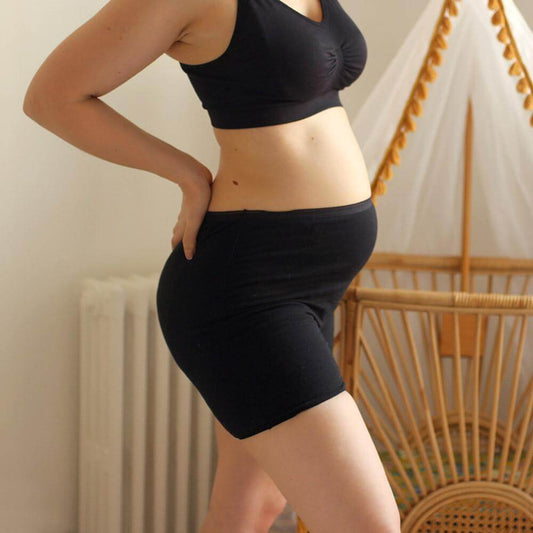Swollen feet and ankles, swollen legs, discomfort in the lower limbs... One pregnant woman in two suffers from water retention during pregnancy. Common during the third trimester, this often benign phenomenon is no less uncomfortable. What are the risks and how can you avoid it ? Elia tells you more and offers advice.
What is water retention?
Water retention, or edema in medical jargon, refers to a significant accumulation of water in body tissue. It most often affects the lower limbs (legs, ankles, feet). It can also affectother parts of the body (face, stomach, fingers, wrists, etc.), as well as organs such as the lungs.
As you're no doubt aware, our bodies are made up of around 65% water. When it functions normally, it eliminates excess fluids through urine, perspiration and respiration. However, our body can store more water than it expels, causing blood vessels to dilate. This phenomenon contributes to the transfer of water from these vessels to the tissues.
Water retention manifests itself as edema or swelling, and sensations of heaviness and stiffness. When it occurs outside pregnancy pregnancyWhen it occurs outside pregnancy, it may be due to prolonged immobility, the use of certain medications or various pathologies (renal or cardiac insufficiency, blood circulation disorders, etc.).
Why does water retention occur during pregnancy?
Pregnancy-related water retention can occur as early as the end of the first trimester, and intensify right up to delivery. This inconvenience particularly affects expectant mothers, whose bodies contain around 4 liters of extra water and whose blood circulation slows down.
Several factors are responsible for water retention in pregnant women:
- Increased secretion of progesterone, which promotes dilation of blood vessels, reduces venous tone and causes salt loss;
- Increased blood volume, which disrupts venous return in the lower body, leading to blood stagnation and water retention during pregnancy;
- Compression of the inferior vena cava by the uterus, which slows blood flow back to the heart;
- Heredity (if members of your family suffer from this condition, you may also be affected);
- Certain more serious illnesses such as pre-eclampsia or severe toxemia.
What are the symptoms of water retention during pregnancy?
Here are the main symptoms of pregnancy water retention:
- Water accumulation in certain subcutaneous tissues;
- Shiny, taut skin;
- Sensation of discomfort, heaviness or stiffness in the lower limbs;
- Swelling of both legs, especially feet, ankles and calves;
- Itching;
- Presence of the bucket sign (fingerprint persisting on the skin for a few seconds after applying pressure for about ten seconds).
What are the risks of water retention during pregnancy?
Water retention during pregnancy is generally benign, and poses no danger to you or your baby(physiological edema). However, if it is accompanied by other symptoms (sudden swelling or rapid weight gain), it could be the result of an underlying condition(pathological edema).
Physiological edema
In the majority of cases, this is moderate, isolated physiological edema caused by poor blood circulation. Progressive swelling of the legs, ankles or feet is perfectly normal during pregnancy, particularly in the third trimester.
Pathological edema
In rare cases, water retention during pregnancy may be caused by a potentially serious illness, such as pre-eclampsia or phlebitis. This is known as pathological edema. Its causes are identified by doctors through clinical examination, blood and urine tests, and blood pressure measurements.
Preeclampsia
Sudden onset of edema in the face, neck, hands or lower limbs, combined with significant weight gain (over 2 kg per week), can presage pre-eclampsia. This pregnancy illness is also characterized by the presence of hypertension (high blood pressure) and abnormally high proteinuria.
If not properly treated, this condition can lead to numerous complications for both mother and baby (fetal growth retardation, premature birth, death of the pregnant woman and her child). If in doubt, consult a doctor or gynecologist as soon as possible.
Beware of phlebitis
Similarly, abnormal and very painful swelling on just one side of the foot or leg may conceal phlebitis or venous thrombosis. This condition is caused by the formation of a blood clot in a vein, leading to partial or complete blockage.
In early pregnancy, the hormones preparing the mother-to-be 's body for childbirth cause blood to coagulate more rapidly. This encourages the formation of blood clots. In the event of ared, hot and very painful oedema on one of your legs, make an appointment with a health professional without delay!
How much weight gain is due to water retention during pregnancy?
Pregnant women gain around 12 kg throughout their pregnancy. During the first two trimesters, they gain one kilo per month. During the third trimester, they tend to gain two kilos a month.
When physiological, water retention leads to pregnancy weight gain of around 1.350 kg. However, it can be as much as 10 kg! If this weight gain is very significant, and is accompanied bymassive oedema localized to the face and hands, we have seen that this could be a sign of pre-eclampsia.
Does water retention disappear after childbirth?
After childbirth, water retention generally disappears within ten days. The body of a new mother eliminates the fluids accumulated during gestation through increased perspiration and more frequent urination. Hormones, including progesterone, drop sharply, reducing water stagnation in the body's tissues.
However,some women continue to experience water retention after pregnancy. Fluids stored over nine months are not evacuated and continue to be retained in certain parts of the body. Swelling of the lower limbs may therefore continue for a few more days. If they persist for more than 15 days and are associated with other symptoms (high blood pressure, localized pain, discoloration of the feet or legs), you should consult your doctor or obstetrician.
Our 4 tips for reducing pregnancy-related water retention!
Want to know how to avoid water retention during pregnancy? Here are four effective tips to reduce the sensation of heavy legs and reduce those annoying swellings!
1. Regular exercise
To reduce water retention during pregnancy, consider regular physical activity. Walking, swimming, gymnastics and prenatal yoga are among the most effective non-impact sports for reducing symptoms. They stimulate blood circulation and prevent fluid stagnation in the lower limbs.
2. Drink plenty of fluids and eat foods that prevent water retention
Contrary to popular belief, drinking plenty of fluids is a natural solution. By consuming at least 1.5 liters of fluids a day, your body is better able to eliminate toxins and the circulation of stagnant water will be more fluid.
Eat foods that help prevent water retention. Choose fruits and vegetables with a low glycemic index. Foods rich in potassium (a mineral essential to the proper functioning of the kidneys and with draining virtues) are particularly effective. These includeartichokes,avocados, bananas, asparagus, spinach, beans and dried fruit.
3. Wear compression stockings or tights
Tights and support stockings are also very effective in combating pregnancy-related water retention. Theyactivate venous return and relieve swollen legs. The models sold today in pharmacies are relatively discreet and comfortable. These medical devices are reimbursed by Social Security up to a limit of 8 pairs per year. You can ask your midwife or gynecologist for a prescription.
4. Elevate your legs for better circulation
Elevate your legs when sitting or lying down. To stimulate blood circulation, you can, for example, slide a rolled-up blanket under your mattress to raise it, or place a maternity cushion under your feet.










